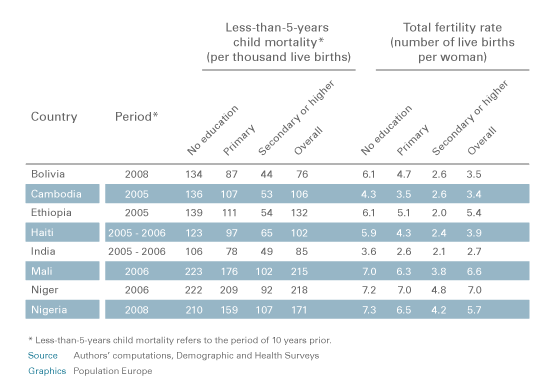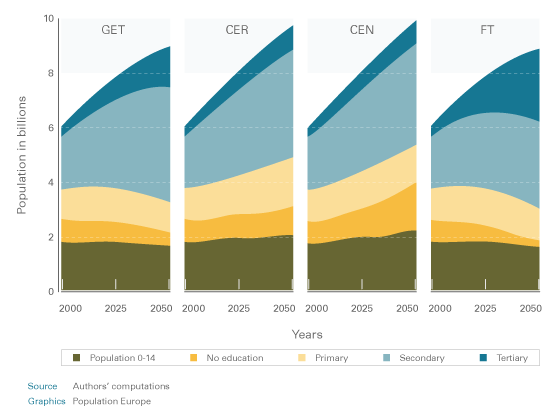The growth of the world population is associated with many challenges in terms of nutrition, health, energy supply and climate effects. But projections on the future global population differ greatly: Will there be nine or ten billion people in 40 years? In four scenarios Wolfgang Lutz and Samir KC show how education can play an important role in slowing down population increase in developing countries.
Educated women have fewer but healthier children
The researchers took a close look at developing countries and examined the effect of women’s education on fertility and infant mortality rates. It turned out that the impact is large, as shown on Table 1. For instance, in Mali a quarter of all children born to women who do not have any education at all die, whereas the mortality rate for children born to women with secondary or higher education is around one-tenth. This is still a high level, but much less than for the uneducated women. In addition, the number of children drops: Whereas on average uneducated Malian women give birth to nearly seven children, for the better educated this number is just around four. In Ethiopia, the fertility rate drops to as low as two children per woman. Educated women are more likely to emphasise the quality of life for their children and they can control their family planning better due to their knowledge of and access to contraception.

Table 1: Impact of women’s education on fertility and infant mortality rates
More data available in the original article
Although the increased education of females leads to the lower mortality of their children, this does not mean that in total the population will grow. The decrease in the number of children educated women have outweighs this effect and leads to a net reduction in population growth rates.
Modeling the future
The fact that education plays such a large role in population growth gives societies opportunities to influence future developments. Lutz’ research team calculates four different future scenarios which differ in their assumptions about school enrolment rates. The first scenario is called the “Fast Track” (FT): It means that countries expand their school systems as strongly and rapidly as possible, a path shown for instance by South Korea and Singapore. The second scenario is the “Global Education Trend” (GET) and is not quite as ambitious. The assumption is that the countries will increase the pace of school expansion in the same way that other somewhat more advanced developing countries have done in the past. With the scenario called the “Constant Enrolment Rate” (CER), the researchers assume that the proportions of school enrolment will stay constant: Because there are more children, they need more schools, but relatively the rate will be the same. In the most pessimistic scenario, called “Constant Enrolment Numbers” (CEN), the absolute number of students and schools will remain the same, so relative to the increased number of children enrolment will decline.
A glance into the future
The results obtained from the different assumptions are astonishing and are shown in Graph 1. In a 40-year period, the Fast Track scenario forecasts one billion people fewer than the pessimistic CEN scenario. One billion – that is the entire population of Africa today or three times that of the U.S.

Graph 1: Scenarios for world population growth
It is quite likely that the effects will be even greater, particularly if community-level factors are also taken into account: If a certain critical proportion of women wants fewer children the values of society can change in such a way that it no longer seems desirable for the majority to have very large families. On the other hand, if population growth is high in a country and the amount of food cannot be increased, it is quite likely that these countries will not be able to build more schools. The number of uneducated women will rise and with them the number of children. All these are possible feed-back effects which have not yet been put into the model.
Shaping the future
The use of education as a strong demographic factor will lead to more reliable forecasts and will open more possibilities to address world population growth. The implications of Lutz’ research are clear: Investing in women’s education and improving access to family planning is necessary.
This PopDigest is also available in French, Spanish and German.
This volume has been published with financial support of the European Union in the framework of Population Europe.